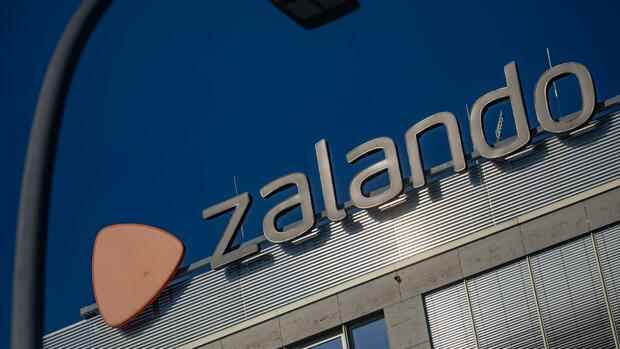Dusseldorf Europe’s largest fashion online retailer Zalando is facing a strong headwind. In the first quarter, sales fell for the first time by 1.5 percent to 2.2 billion euros, as the Berlin Dax group announced on Thursday. After extraordinarily strong growth in the same quarter of the previous year, the gross goods volume rose by only one percent to 3.2 billion euros in the first quarter of 2022.
The net gain became a net loss. Because of the continued high investments in the logistics network, Zalando slipped into the red. From January to March, the company reported an adjusted operating loss (EBIT) of almost EUR 52 million. For comparison, in the first quarter of 2021 it was still plus 93 million euros. The EBIT margin also fell from 4.2 to 2.4 percent.
Co-CEO Robert Gentz sees the expected changes in consumer behavior after the pandemic as one reason for this – i.e. that customers are again spending part of their money in stationary retail.
Then there was inflation and war. Both lead to the fact that one either buys less and more expensively, or just cheaper. Supply chain problems, on the other hand, would only have a minor impact.
Top jobs of the day
Find the best jobs now and
be notified by email.
Gentz announced that the most important measures would be to optimize both purchasing and the cost structure. In addition, the increased logistics costs would be passed on to the logistics service providers. Reasons for the bad margin are above all the higher marketing expenses and the increased logistics costs at the same time.
Zalando wants to continue to stick to its goals
Despite the normalization, Zalando intends to stick to both its short-term and long-term goals. The fashion retail platform is sticking to its forecast for the 2022 financial year at the lower end.
The gross goods volume should then grow between 16 and 23 percent, sales between 12 and 19 percent. Adjusted EBIT should be at the lower end of the range between 430 and 510 million euros, with investments closer to 400 than 500 million euros. Above all, Zalando wants to expand logistics, including the construction of new logistics centers in Frankfurt.
While gross merchandise volume rose slightly, sales fell. CFO Sandra Dembeck explained that 32 percent of sales are now generated through the partner business, while Zalando only receives a fee for the presentation on the portal and the costs are reimbursed, but also does not bear the risk of the goods so much. Gentz added that Zalando reacted faster to the range than its partners.
In 2021, Zalando had turned over EUR 10.35 billion, gross merchandise volume had climbed to EUR 13 billion and Zalando had met expectations in 2021. EBIT increased by eleven percent to 468.4 million euros in 2021. For 2022, Zalando is promising a wide range of between 430 and 510 million euros.
Profitability, on the other hand, fell slightly in 2021. The adjusted EBIT margin fell from 5.3 to 4.5 percent in 2021. A margin of between 3.7 and 4.1 percent is expected for 2022. The average shopping cart shrank slightly by 1.3 percent, although customers ordered 5.2 times as often compared to the previous year – and thus more often than ever before.
When the annual figures were presented in March, the company expected sales growth of twelve to 19 percent to a maximum of 12.3 billion euros for 2022.
Stock price is far from peak
At the beginning of July 2021, the Zalando share price reached its highest price of EUR 105.90 and its low of EUR 35.12. On Thursday morning, the share was around 38 euros and lost 3.6 percent to 36.64 euros. The price had been moving steadily downwards in the past few weeks.
Analysts see the middle price target at EUR 84.27. In autumn, the company, which has been listed on the stock exchange since 2014, was promoted to the now extended Dax-40. In the past few days, Zalando has been at the bottom of the leading index.
In April, the company hit the headlines because Rubin Ritter, who left the board in summer 2021, received compensation of 89 million. He had exercised stock options he received in 2011, 2013 and 2014.
The two founders and co-CEOs Robert Gentz and David Schneider each received 45.5 million euros. The company, which has been listed on the stock exchange since 2014, has now introduced a cap of EUR 15.75 million for the remuneration of CEOs, and EUR 10.5 million for other board members.
Dembeck, who came to Zalando from caterer Compass Group in March, presented the figures for the first time as the new CFO. The previous CFO David Schröder is now COO. After HR manager Astrid Arndt, the 47-year-old is the second woman on the six-member board.
Zalando’s goals are ambitious: by 2025, half of the gross merchandise volume is to be generated via partners, currently it is 30 percent. Almost 7,000 shops across Europe sold via the Zalando platform.
In 13 out of 23 markets in which Zalando is active, shops can currently sell their clothing via Zalando. After a phase during the pandemic in which they did not have to pay any commission and a transition phase with lower fees, full commissions are now being paid to Zalando again.
Zalando is also making progress when it comes to sustainability, with 140,000 items now being sustainable, which is almost 22 percent of the gross goods volume; in 2020 it was 16 percent. In the area of second-hand fashion, there are now 400,000 products on offer.
More: Zalando co-boss receives 89 million euros as a farewell
